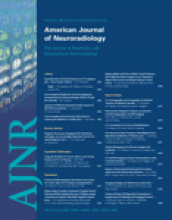Abstract
BACKGROUND AND PURPOSE: To report morbidity, mortality, and angiographic results of elective coiling of unruptured intracranial aneurysms.
METHODS: In a 10-year period, 176 unruptured aneurysms in 149 patients were electively treated with detachable coils. Seventy-nine aneurysms were additional to another ruptured aneurysm but were coiled more than 3 months after subarachnoid hemorrhage, 59 aneurysms were incidentally discovered, and 38 aneurysms presented with symptoms of mass effect. Mean size of the 176 unruptured aneurysms was 10.6 mm (median, 8 mm; range, 2–55 mm). One hundred thirteen aneurysms (64%) were small (<10 mm), 44 aneurysms (25%) were large (10–25 mm), and 19 aneurysms (11%) were giant (25–55 mm). Thirty wide-necked aneurysms (17%) were coiled with the aid of a supporting device.
RESULTS: Procedural mortality of coiling was 1.3% (2 of 149; 95% confidence interval [CI], 0.7–5.1%), and morbidity was 2.6% (4 of 149, 95% CI, 0.8–7.0%). The 4 patients with permanent morbidity were independent (GOS 4). Initial aneurysm occlusion was complete (100%) in 132 aneurysms, nearly complete (90%–98%) in 36 aneurysms, and incomplete (60%–85%) in 8 aneurysms. Six-month follow-up angiography was available in 132 patients with 154 coiled aneurysms (87.5%); partial reopening occurred in 25, mainly large and giant aneurysms (16.2%). Additional coiling was performed in 22 aneurysms and additional parent vessel occlusion in 1 aneurysm. There were no complications of additional treatments.
CONCLUSION: Elective coiling of unruptured intracranial aneurysms has low procedural mortality and morbidity. For the management of unruptured aneurysms, endovascular treatment should be considered.
- Copyright © American Society of Neuroradiology












